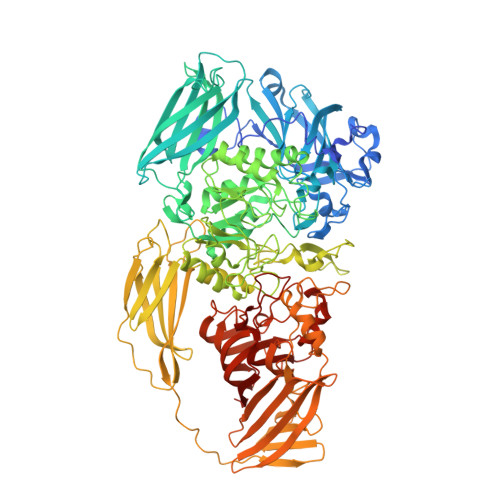Ser-796 of Beta-Galactosidase (E. coli) Plays a Key Role in Maintaining an Optimum Balance between the Opened and Closed Conformations of the Catalytically Important Active Site Loop
Jancewicz, L.J., Wheatley, R.W., Sutendra, G., Lee, M., Fraser, M.E., Huber, R.E.(2012) Arch Biochem Biophys 517: 111-122
- PubMed: 22155115
- DOI: https://doi.org/10.1016/j.abb.2011.11.017
- Primary Citation of Related Structures:
3SEP, 3T08, 3T09, 3T0A, 3T0B, 3T0D, 3T2O, 3T2P, 3T2Q - PubMed Abstract:
A loop (residues 794-803) at the active site of ¶¬-galactosidase (Escherichia coli) opens and closes during catalysis. The ¶Ń and ¶¬ carbons of Ser-796 form a hydrophobic connection to Phe-601 when the loop is closed while a connection via two H-bonds with the Ser hydroxyl occurs with the loop open. ¶¬-Galactosidases with substitutions for Ser-796 were investigated. Replacement by Ala strongly stabilizes the closed conformation because of greater hydrophobicity and loss of H-bonding ability while replacement with Thr stabilizes the open form through hydrophobic interactions with its methyl group. Upon substitution with Asp much of the defined loop structure is lost. The different open-closed equilibria cause differences in the stabilities of the enzyme°§substrate and enzyme°§transition state complexes and of the covalent intermediate that affect the activation thermodynamics. With Ala, large changes of both the galactosylation (k(2)) and degalactosylation (k(3)) rates occur. With Thr and Asp, the k(2) and k(3) were not changed as much but large ¶§H(?) and T¶§S(?) changes showed that the substitutions caused mechanistic changes. Overall, the hydrophobic and H-bonding properties of Ser-796 result in interactions strong enough to stabilize the open or closed conformations of the loop but weak enough to allow loop movement during the reaction.
Organizational Affiliation:
Division of Biochemistry, University of Calgary, Calgary, Alberta, Canada.




















